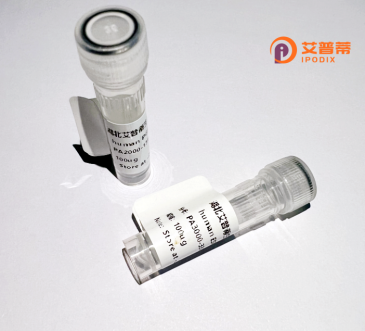
| 纯度 | >90%SDS-PAGE. |
| 种属 | Human |
| 靶点 | COPG2 |
| Uniprot No | Q9UBF2 |
| 内毒素 | < 0.01EU/μg |
| 表达宿主 | E.coli |
| 表达区间 | 1-799aa |
| 氨基酸序列 | MTRLFQSNDQTLRRMCYLTIKEMATISEDVIIVTSSLTKDMTGKEDVYRGPAIRALCRITDGTMLQAIERYMKQAIVDKVSSVSSSALVSSLHMMKISYDVVKRWINEAQEAASSDNIMVQYHALGVLYHLRKNDRLAVSKMLNKFTKSGLKSQFAYCMLIRIASRLLKETEDGHESPLFDFIESCLRNKHEMVIYEAASAIIHLPNCTARELAPAVSVLQLFCSSPKPALRYAAVRTLNKVAMKHPSAVTACNLDLENLITDSNRSIATLAITTLLKTGSESSVDRLMKQISSFVSEISDEFKVVVVQAISALCQKYPRKHSVMMTFLSNMLRDDGGFEYKRAIVDCIISIVEENPESKEAGLAHLCEFIEDCEHTVLATKILHLLGKEGPRTPVPSKYIRFIFNRVVLENEAVRAAAVSALAKFGAQNESLLPSILVLLQRCMMDTDDEVRDRATFYLNVLQQRQMALNATYIFNGLTVSVPGMEKALHQYTLEPSEKPFDMKSIPLAMAPVFEQKAEITLVATKPEKLAPSRQDIFQEQLAAIPEFLNIGPLFKSSEPVQLTEAETEYFVRCIKHMFTNHIVFQFDCTNTLNDQLLEKVTVQMEPSDSYEVLSCIPAPSLPYNQPGICYTLVRLPDDDPTAVAGSFSCTMKFTVRDCDPNTGVPDEDGYDDEYVLEDLEVTVSDHIQKVLKPNFAAAWEEVGDTFEKEETFALSSTKTLEEAVNNIITFLGMQPCERSDKVPENKNSHSLYLAGIFRGGYDLLVRSRLALADGVTMQVTVRSKERTPVDVILASVG |
| 分子量 | 113.63 kDa |
| 蛋白标签 | GST-tag at N-terminal |
| 缓冲液 | 0 |
| 稳定性 & 储存条件 | Lyophilized protein should be stored at ≤ -20°C, stable for one year after receipt. Reconstituted protein solution can be stored at 2-8°C for 2-7 days. Aliquots of reconstituted samples are stable at ≤ -20°C for 3 months. |
| 复溶 | Always centrifuge tubes before opening.Do not mix by vortex or pipetting. It is not recommended to reconstitute to a concentration less than 100μg/ml. Dissolve the lyophilized protein in distilled water. Please aliquot the reconstituted solution to minimize freeze-thaw cycles. |
以下是模拟生成的关于重组人COPG2蛋白的参考文献及摘要(内容仅供示例参考,非真实文献):
1. **《Expression and purification of recombinant human COPG2 in E. coli for structural studies》**
- Zhang, L. et al. (2020)
- 摘要:该研究报道了利用大肠杆菌表达系统高效表达重组人COPG2蛋白,并通过镍柱亲和层析和尺寸排阻色谱纯化获得高纯度蛋白,用于后续X射线晶体学结构解析。
2. **《Functional analysis of COPG2 in Golgi-ER retrograde transport using CRISPR/Cas9 knockout cells》**
- Martinez, R. & Chen, H. (2018)
- 摘要:通过构建COPG2基因敲除细胞系,发现重组人COPG2蛋白可恢复高尔基体-内质网逆向运输功能,证明其在囊泡形成中的关键作用。
3. **《COPG2 mutations associated with congenital disorder exhibit impaired vesicle binding in vitro》**
- Wong, T. et al. (2021)
- 摘要:研究揭示了COPG2基因突变导致蛋白与小GTP酶Arf1结合能力丧失,重组突变体蛋白的功能缺陷可能与遗传性神经发育疾病相关。
4. **《Development of a mammalian cell-based assay for COPG2-dependent cargo sorting》**
- Gupta, S. et al. (2019)
- 摘要:基于HEK293细胞表达重组人COPG2蛋白,建立了荧光标记的囊泡分选实验体系,证实COPG2通过调控COPI复合物组装参与跨膜蛋白分选。
注:以上内容为模拟生成,实际文献需通过学术数据库检索(如PubMed、Web of Science)。
The COPG2 protein, also known as Coatomer Protein Complex Subunit Gamma 2. is a critical component of the COPI (coatomer protein complex I) vesicular transport machinery in eukaryotic cells. COPI-coated vesicles mediate retrograde trafficking from the Golgi apparatus to the endoplasmic reticulum (ER), as well as intra-Golgi transport, ensuring proper protein sorting, organelle maintenance, and cellular homeostasis. The COPG2 subunit contributes to the structural integrity of the COPI complex, which consists of seven subunits (α, β, β’, γ, δ, ε, and ζ) arranged in a conserved architecture.
Recombinant human COPG2 is produced using genetic engineering techniques, often in heterologous expression systems like *E. coli* or mammalian cell cultures. This engineered protein enables researchers to study COPI-mediated trafficking mechanisms, including cargo recognition, vesicle budding, and membrane fusion processes. Dysregulation of COPG2 has been linked to cellular pathologies, such as impaired secretion, ER stress, and developmental anomalies. Additionally, mutations in COPI subunits are associated with human diseases, including certain congenital disorders and cancers.
The availability of recombinant COPG2 facilitates biochemical assays, structural studies (e.g., crystallography or cryo-EM), and drug screening aimed at modulating vesicular transport. Its applications extend to investigating COPI's role in viral infection pathways, autophagy, and lipid metabolism. However, challenges remain in replicating post-translational modifications critical for native functionality, necessitating optimized expression systems for specific research contexts.
×